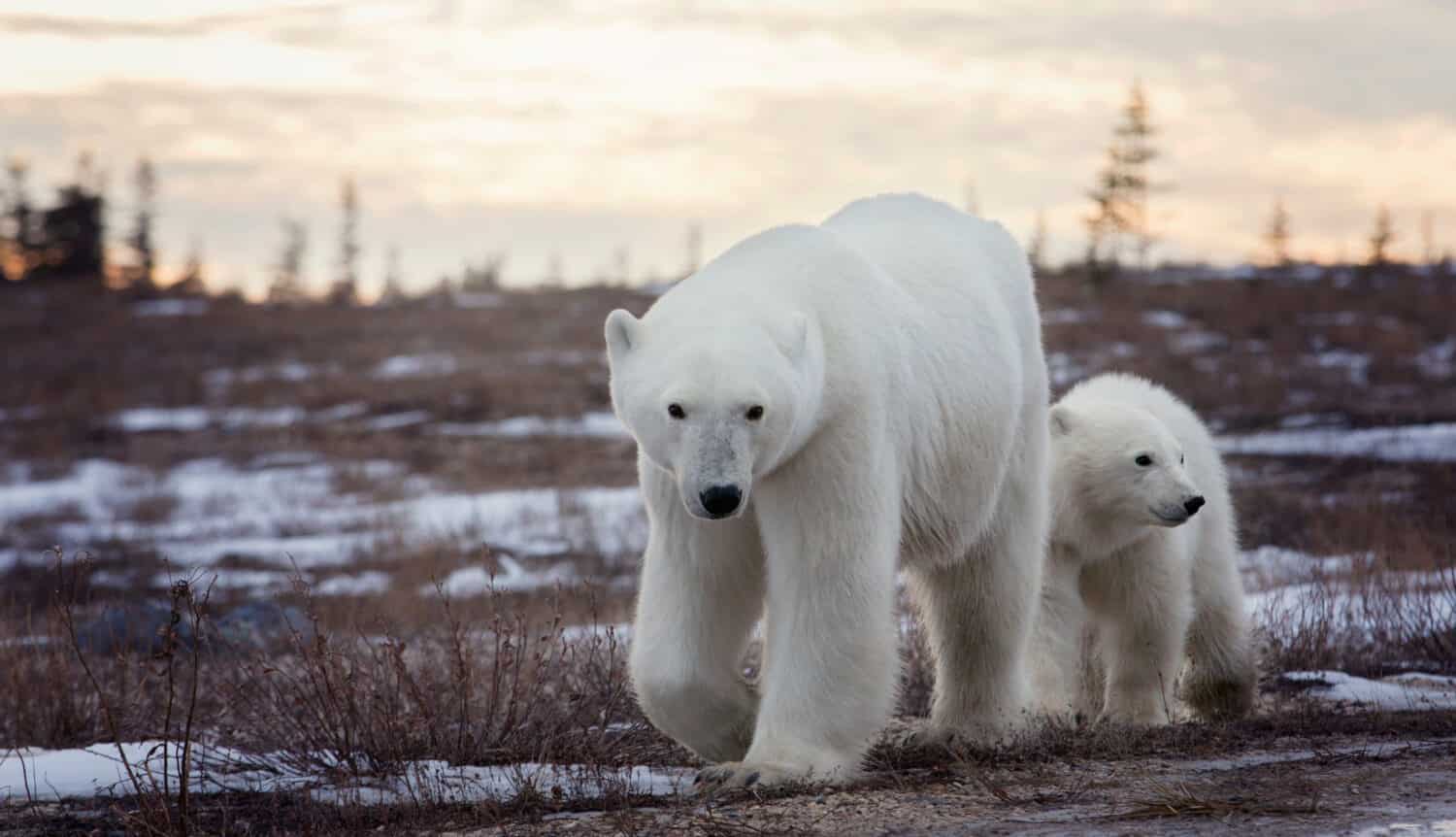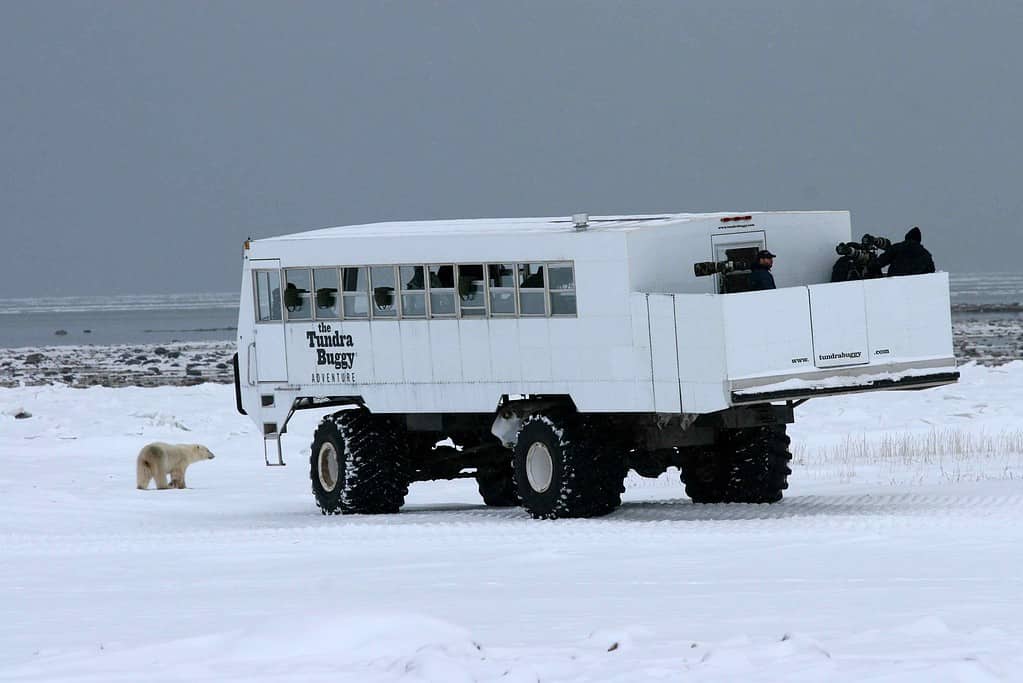You can’t just drive to the “polar bear capital of the world,” as there are no roads that go there!
To get to this tiny town perched on the western shore of Hudson Bay you’ll have to either fly in or take a train from a more “civilized” location.
But a trip to Churchill, in the Canadian province of Manitoba, is an adventure that shouldn’t be missed.

Churchill, Manitoba is situated in the midst of an ancient migration path for polar bears.
©critterbiz/Shutterstock.com
Largest Land Predator in the World
The thrill of seeing a 1,500-pound polar bear (Ursus maritimus) in its native surroundings is what draws over 10,000 visitors a year to the frontier community of Churchill.
From late summer through mid-October and November, polar bears wander freely around Churchill and its surrounding areas. They stay until the ice on Hudson Bay is solid enough to hunt from. Churchill, just slightly south of the Arctic Circle, was built smack in the middle of the natural migration path of these carnivores, the largest land predators in the world.
These impressive mammals survive by taking to the ice flows in the bay. They hunt for seals when they surface to breathe. But until the weather is cold enough, the bears tend to hang out in this sub-artic tundra town. They’re both a scary presence and a sight to behold.
While thousands flock to Churchill for the excitement of seeing these bears in their natural habitat, it’s not without a fear factor!

A Different Kind of Neighborhood Watch

The quaint town of Churchill, Manitoba, dubbed the Polar Bear Capital of the World.
During the summer months, into late November, an estimated 1,000 polar bears migrate into Churchill. So, first-time visitors hoping to see a polar bear lounging around, playing, or rambling along, likely won’t be disappointed. But that also comes with a certain amount of risk.
Locals know full well that you don’t want to be caught off guard during polar bear season. Officials say Churchill is always on “polar bear alert,” but that August through November are the “high alert months.”
Signs providing a “polar bear alert” warning to “STOP, don’t walk in this area” are certainly helpful. But the most important safety-related measure is one dubbed “bear-dar,” more officially known as the “polar bear alert program.” That’s a 24-hour hotline where a bear spotted in or near the town is phoned in using the bear “hotline.”
Folks in Churchill also make it a practice to not lock their car doors in case someone needs quick shelter from an approaching bear. They are also warned not to walk outside after 10 P.M. A siren sounds every night at that time to remind everyone to head indoors. People also make use of “bear bangers,” (loud cap guns) to scare bears away or fire regular guns in the air.
A photojournalist who visited Churchill recently commented “You can’t be anywhere by yourself. You have to have a vehicle or someone with you or some means of scaring a bear.” But some of these bears just don’t scare that easily. And should one persist in staying too close to town for comfort, it is likely to end up “doing time.”
Bear Incarceration

When the bear patrol can’t get a wayward bear to leave the city proper, it’s trapped, taken to a holding facility, and later released.
©Enrico Pescantini/Shutterstock.com
Polar bears who can’t take a hint from the “bear patrol,” which uses noise, rubber bullets, or paint guns to encourage them to beat a hasty retreat from town, will be trapped or tranquilized and hauled off to the Polar Bear Holding Facility.
Known as the “bear jail” this former aircraft hanger has room for up to 28 wayward bears at a time. Five of the holding pens are air-conditioned for use in the summer. How long a bear is held depends on several factors.
The area where bears may be hauled off to “jail” consists of Zone 1, Churchill’s central living and working area, Zone 2, known as the “inhabited perimeter area” and Zone 3, the “remote area.”
If a bear is captured inside Zone 1, it is immediately removed for safety reasons and held for a minimum of 30 days. The exceptions are family groups, which are relocated as soon as possible.
But any bear that ends up in the holding facility is given a health check, measured, tagged, and added to the database. Since polar bears don’t eat until the ice freezes solid during seal hunting season (living off their body fat in the meantime), they are given water or snow while in holding, but no food.
Where Are the ‘Arrested’ Bears Released?

All-terrain bear buggies allow visitors to get a good glimpse of polar bears in their natural habitat.
©Thomas Barrat/Shutterstock.com
Where officials release a polar bear from jail depends on the season. If it’s the summer season or anytime before the freeze-up, the bear is tranquilized and taken by a helicopter using a net sling 40 or so miles north of Churchill and released.
After November, any bear in holding is placed in a large trap that is towed directly to the shoreline. As a Manitoba bear expert explained, “When the bears see the ice they are more than happy to get out on it and to start hunting for seals.”
Taking a Ride on the Bear ‘Buggy’

The Bear or Tundra Buggy takes people on tours of the tundra surrounding Churchill where wild polar bears can be viewed.
While polar bears aren’t exactly given the welcome mat in town, you don’t have to go very far to find them. All-terrain vehicles that transverse the tundra looking for bears range from those offering day trips to luxury train-like coaches with sleeping accommodations.
These large, tank-like vehicles venture out to the Churchill Wildlife Management Area. They are built to keep sightseers safe but still provide ample viewing windows. They even have a back “porch” to get the best photos and videos. Many also have multiple skylights to allow for breathtaking views of the aurora borealis when conditions cooperate.
These Feet Were Made for Swimming

This close-up of a polar bear’s feet gives a good look at how this animal is ideally suited to live in such a harsh climate.
©Angelica Corneliussen/Shutterstock.com
Polar bears are the only bear species classified as marine mammals! Although they’re amazing swimmers, they still need ice flows for successful seal hunting.
The design of the bear’s body adapts it perfectly to icy ground and frigid water. Its water-repellant fur and buoyant stores of body fat keep it warm, and its huge, semi-webbed paws propel it through the water like a large fish.
Their phenomenal feet are also well adapted to walking on snow and ice. With fur on their paws for protection, sharp claws, and bumps on their feet for traction, polar bears are ideally suited to survive their harsh environment.
The Churchill ‘Trifecta’

Seeing, and even paddling with beluga whales is another reason tourists flock to Churchill.
©YVETTE BARNETT/Shutterstock.com
The month of August in this remote outpost gives lucky visitors the chance to win the Churchill “trifecta.”
That would be bears, beluga whales, and the ribbons of green light in the sky known as the northern lights.
Churchill offers a variety of guided whale-watching expeditions. Unlike those geared to bears, these are more up close and personal. That’s because beluga whales (Delphinapterus leucas) are among the most sociable of marine mammals. Not only do they live in groups of various sizes, called pods, but they often get close to people, too. Belugas are also known to be the most vocal animals in the world. They feed on the rich ocean habitat of salmon, herring, and a variety of shellfish.
Getting up Close to Belugas
Beluga sightings during the summer are easy to come by, as thousands inhabit the Churchill River, with many more in Hudson Bay.
Ways to get close to these gentle cetaceans include boats, kayaks, and going out on a stand-up paddleboard. Since belugas are naturally friendly and curious, having them come right up to a boat or paddleboarder is expected — and fun.
Snow-white belugas are deep divers, that can swim at speeds up to 13 miles per hour. Their only natural predators are orcas and polar bears.
‘If You Don’t Like the Weather, Just Wait a Few Minutes’

The best month to view the northern lights in Churchill is said to be March.
©Pi-Lens/Shutterstock.com
Although Mark Twain said that about New England, it applies even more to Churchill!
Weather swings in this area are common. There can be clear skies in Churchill while only a few minutes away you’ll encounter gusty winds and stormy conditions.
In this area’s subarctic continental climate, summers are chilly and short while the winters are long and cold. A typical summer “heat wave” might get up to 59 degrees Fahrenheit (15 Celsius).
Visiting Churchill during its arctic summer or fall is sure to be one of the most unique experiences any traveler can have.
Just be sure to pack plenty of warm clothing, a camera, and extra batteries!
The photo featured at the top of this post is © CherylRamalho/Shutterstock.com
Thank you for reading! Have some feedback for us? Contact the AZ Animals editorial team.







